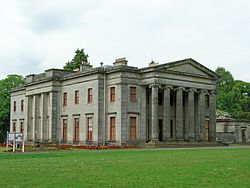Camperdown Country Park
| Camperdown House | |
|---|---|
 Camperdown House, June 2006 | |
| Area | 400 acres (1.6 km2) |
Listed Building – Category A | |
| Designated | 12 July 1963 |
| Reference no. | 25078 |
| Designated | 1987 |
Camperdown Country Park, often known as just Camperdown Park, is a public park in the Camperdown area of Dundee, Scotland. The park comprises the former grounds of Camperdown House, a 19th-century mansion, which was bought by the city in 1946. Camperdown Park is home to a wildlife centre and recreational facilities. It is the largest park in Dundee,[1] stretching to 400 acres (1.6 km2).[2] Over 190 species of tree are found in the park.[1][2]
Camperdown House is "the largest Greek Revival house remaining in Scotland."[3] It is protected as a category A listed building, and the park is included on the Inventory of Gardens and Designed Landscapes in Scotland, the national listing of significant parks.[4]
History
The Camperdown estate was originally known as Lundie, and was bought by Alexander Duncan in 1682. A 16th-century house stood on the estate at this time. Several members of the family served as Provost of Dundee during the 18th century. In 1797, during the French Revolutionary Wars, Admiral Adam Duncan (1731–1804) commanded the Royal Navy fleet that defeated the Dutch at the Battle of Camperdown. He was rewarded by being raised to the peerage as Viscount Duncan.[5]
In 1820, his son Robert, 2nd Viscount Duncan, commissioned William Burn to design a new house in the Greek Revival style. The earlier house was demolished, and the new house was completed in 1828.[3] Lord Duncan renamed the house and estate Camperdown in memory of his father's victory,[5] and in 1831 he was created Earl of Camperdown by William IV. The parklands surrounding the house were laid out by Lord Camperdown, with the assistance of his forester David Taylor, who along with his son planted most of the estate's trees between 1805 and 1859.[5]
After the death of the 4th Earl of Camperdown in 1933, the earldom became extinct, and Camperdown was inherited by a cousin, Georgiana, widow of the 7th Earl of Buckinghamshire. On her death in 1937, the contents were sold, and the house followed, being bought by the Corporation of Dundee in 1946.[5] Camperdown Country Park officially opened to the public in 1949.[1]

Camperdown Elm
Camperdown is notable in horticulture as the origin of the Camperdown Elm (Ulmus glabra 'Camperdownii'), a short, broad, "weeping" variety of elm. The tree was discovered in around 1835-1840 by Lord Camperdown's head forester, David Taylor, who noticed a mutant contorted wych elm branch sprawling along the ground. The earl's gardener produced the first Camperdown Elm by grafting it to the trunk of a normal wych elm (Ulmus glabra). Every Camperdown Elm is from a cutting taken from that original tree and is grafted on a U. glabra trunk.
Facilities

Wildlife Centre
The Camperdown Wildlife Centre is home to over 300 animals,[6] of 50 different species.[7] The centre contains mainly mammals and birds. Comet and Star, the two brown bears, are one of the most popular places in the centre. Britain's rarest mammal, the pine marten, can also be found in the centre.[7] Camperdown Wildlife Centre received its "zoo licence" in September 2003.[8] The park made news headlines in 1986 when "Jeremy", its female European brown bear, bit the arm off ten-year-old Ross Prendergast, who had sneaked into the park after hours. The captive well loved bear paid with it's life, being secluded for a time before being euthanised. [8][9] The bear enclosure has been enlarged since the incident, and there are now two different bears at the park.
Adventure playground
There is a large play area for young children to play in. A refreshments area is beside the park for refreshments. Pedal-boats are available during the summer months, as are the go-karts. The play-area is fenced off so children can play safely in the park, without parents having the risk of their children running into the water or getting lost.
Golf course
Camperdown Country Park has an 18-hole golf course. It is 6548 yards in length. It was opened in 1959 and became a very popular golf course. During the 1970s the course held the British Police Championship, and (with the Downfield Golf Course) the Scottish Stroke-Play Championship.[10]
Family funfair
During the summer months, the family funfair is at the park. Rides include a small rollercoaster, teacups, and other rides for adults and children of all ages.
References
- ^ a b c "Camperdown Country Park". camperdownpark.com. Camperdown Park. Retrieved 17 March 2012.
- ^ a b "Camperdown Country Park". information-britain.co.uk. Information Britain. Retrieved 17 March 2012.
- ^ a b "Camperdown House: Listed Building Report". Historic Scotland. Retrieved 13 September 2011.
- ^ "Camperdown House". Inventory of Gardens and Designed Landscapes in Scotland. Historic Scotland. Retrieved 13 September 2011.
- ^ a b c d "Camperdown House: Site History". Inventory of Gardens and Designed Landscapes in Scotland. Historic Scotland. Retrieved 13 September 2011.
- ^ "Camperdown Park". scottish-places.info. The Editors of The Gazetteer for Scotland. Retrieved 18 March 2012.
- ^ a b "Camperdown Country Park". aboutbritain.com. Excelsior Information Systems Limited. Retrieved 18 March 2012.
- ^ a b "Size of bear enclosure set to be increased". The Courier. Retrieved 17 April 2009.
- ^ The Mammoth Book of Maneaters - Google Book Search. Retrieved 17 April 2009.
- ^ "The History of Both Golf Courses". dundeecity.gov.uk. Dundee City. Retrieved 17 March 2012.
External links
![]() Media related to Camperdown Country Park at Wikimedia Commons
Media related to Camperdown Country Park at Wikimedia Commons

